Nepal After the Coup
KATHMANDU, Nepal
In the three months since King Gyanendra Bir Bikram Shah Dev executed an audacious royal coup, his forces have dismantled much of the country’s once-thriving independent news media.
Dozens of journalists have been arrested and detained, their patriotism questioned and their safety threatened. Blank pages in magazines and newspapers reflected sweeping bans on news reporting, and the censors’ insidious hand continues to suppress coverage every day in less obvious ways. The king’s forces and the civilian administration have moved now to coercive financial tactics, cutting off government advertising revenue and using the state’s regulatory muscle to pressure the country’s largest news outlet. By one estimate, as many as 2,000 journalists have lost their jobs nationwide.
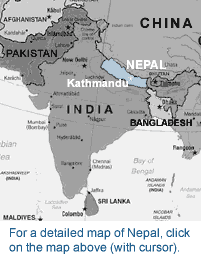 The government has utterly shut down news reporting on FM radio, a primary source of information in Nepal, especially in rural and remote areas of the countryside. FM was a flourishing news venue until just weeks ago, offering news in many languages, helping build a national identity, and fostering debate on vital issues. Now, an estimated 1,200 FM radio journalists are idle, and music has replaced the news bulletins and community discussion programs that made FM popular.
The government has utterly shut down news reporting on FM radio, a primary source of information in Nepal, especially in rural and remote areas of the countryside. FM was a flourishing news venue until just weeks ago, offering news in many languages, helping build a national identity, and fostering debate on vital issues. Now, an estimated 1,200 FM radio journalists are idle, and music has replaced the news bulletins and community discussion programs that made FM popular.
Many nations have spoken out against the king’s breathtaking grab at power, forcing the regime to accept the deployment of United Nations monitors to document human rights and press abuses. Nepal’s 14-year-old democracy has indeed been deeply troubled–beset by a bloody and protracted conflict with Maoist rebels–but it did foster the creation of a robust independent news media (see “A young, vibrant media”). A number of these independent journalists in Nepal are now risking their lives and security, challenging the government and pushing restrictive boundaries. Yet, as each day ticks by, the government moves ever closer to a state-controlled press.
“The censorship, the self-censorship, and the intimidation, and the demoralization are massive,” said Kanak Dixit, publisher of the Nepali-language Himal Khabarpatrika.
The Committee to Protect Journalists met with dozens of journalists, activists, and publishers in April to assemble this alarming portrait of Nepalese press conditions. Palace representatives did not respond to CPJ’s request to meet with King Gyanendra to discuss the crisis. Tanka Dakhal, Nepal’s Minister for Information and Communications, did not respond to a series of requests from CPJ seeking a meeting. Brig. Gen. Dipak Gurung, a spokesman for the Royal Nepal Army, spoke with CPJ by telephone. Gurung said he would address complaints involving army harassment of the press that were referred to him by CPJ.
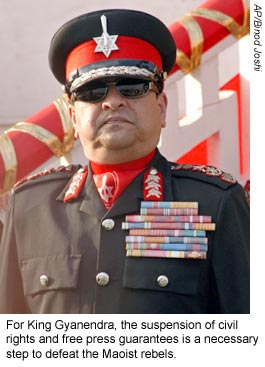 Just before 10:30 a.m. on February 1, 2005, King Gyanendra went on radio and television to announce the dismissal of the government and the imposition of a state of emergency. Fundamental rights–including freedom of speech and freedom of the press–were suspended indefinitely. The measures were necessary, the king said, to allow the security forces a freer hand against Maoist rebels who now control up to three quarters of the rural districts of Nepal and wield great influence over much of the rest of the country.
Just before 10:30 a.m. on February 1, 2005, King Gyanendra went on radio and television to announce the dismissal of the government and the imposition of a state of emergency. Fundamental rights–including freedom of speech and freedom of the press–were suspended indefinitely. The measures were necessary, the king said, to allow the security forces a freer hand against Maoist rebels who now control up to three quarters of the rural districts of Nepal and wield great influence over much of the rest of the country.
In his speech, the king offered reassurance that free expression is among “the inherent features of multiparty democracy” and that the press “serves as the medium for raising the level of democratic consciousness.”
But the actions of the king’s forces were at odds with his lofty rhetoric. Before the king’s address even began, the Royal Nepal Army was deployed to enforce the newly imposed restrictions on the media. Armed soldiers went to newspapers and radio stations with instructions to prevent publication or broadcast of anything that violated “the letter or spirit” of the royal proclamation.
Narayan Wagle, editor of the country’s largest circulation Nepali-language newspaper, Kantipur, arrived at work to find the building surrounded and the newsroom occupied by soldiers. “There were 40 or 50 of them,” Wagle said, “all in uniform, all armed and spread out as if in battle order. We had men with M-16 rifles in our newsroom, officers going through the news pages and telling us what to write. They were polite enough, but every time you turned around there was a soldier with a gun.”
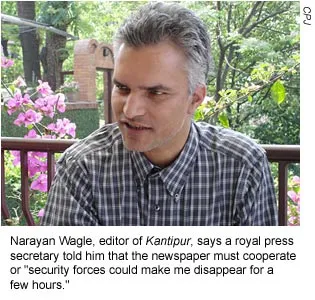 The scene was repeated in newsrooms across Kathmandu, but special attention was paid to the capital’s FM radio stations, all of which had been ordered in advance to broadcast the speech. As the king’s proclamation was being relayed, soldiers arrived to enforce those royal orders.
The scene was repeated in newsrooms across Kathmandu, but special attention was paid to the capital’s FM radio stations, all of which had been ordered in advance to broadcast the speech. As the king’s proclamation was being relayed, soldiers arrived to enforce those royal orders.
“I looked out of my window, and three army jeeps were parked in front of our building,” said Gopal Guragain, founder of the FM news and current affairs network, Communications Corner, which supplies programs to 14 stations across the country and operates one of its own. “Soldiers went to our station, Nepal FM. They came into the newsrooms and demanded that we close down, stop broadcasting. We told them we were putting out the king’s speech and nothing else, and after it was over, we’d run clips as our only news item. They agreed, but stayed there with their guns. It was extremely frightening.”
Similar situations were reported at Radio Sagarmatha, City FM, Star FM, Radio Metro, Kantipur FM, and other stations in Kathmandu.
Outside of the capital, the king’s forces used different approaches. In some areas, newspapers were ordered to stop publication and given no indication when they might be allowed to resume. The military closed some radio stations for a few days, while forcing others to play only music or clips of the king’s speech. Announcers were told not to open their microphones–not to identify songs, not even to give the time of day.
State-run Radio Nepal dropped BBC’s Nepali-language news service entirely, and briefly stopped broadcasting BBC World Service’s English-language reports. When it resumed the BBC World Service broadcasts, it replaced the first 15 minutes of each hour with patriotic music. Items about Nepal in the news headlines or opening sequences of the program were effectively preempted.
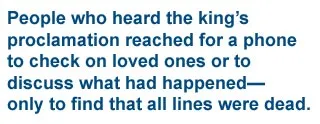 In the aftermath of the king’s proclamation, cable television companies discontinued international news channels from India, Britain, and the United States, although it’s not clear whether the owners pulled the plug as a precaution or did so on government orders. For much of the day on February 1, there was no BBC World, no CNN, and no Star or Zee TV news from India. The remaining television stations offered soap operas and pop videos, leaving the nation without access to independent news immediately after the king’s dramatic announcement. In the coming days, most television stations were restored to cable networks, but a few Indian channels–blamed in the past for sensationalist reporting on events in Nepal–were still not available by mid-April.
In the aftermath of the king’s proclamation, cable television companies discontinued international news channels from India, Britain, and the United States, although it’s not clear whether the owners pulled the plug as a precaution or did so on government orders. For much of the day on February 1, there was no BBC World, no CNN, and no Star or Zee TV news from India. The remaining television stations offered soap operas and pop videos, leaving the nation without access to independent news immediately after the king’s dramatic announcement. In the coming days, most television stations were restored to cable networks, but a few Indian channels–blamed in the past for sensationalist reporting on events in Nepal–were still not available by mid-April.
The February 1 restrictions went beyond the media. The king’s speech had barely finished when all telephone lines in Nepal were blocked and the national cell phone network was switched off. People who had just heard the monarch proclaim his takeover reached for a phone to check on loved ones or to discuss what had happened–only to find that all lines were dead. All six of the country’s Internet service providers were shut down by the army, blocking local access to the Internet and preventing the updating of Nepal-based news Web sites.
“It was chilling,” said the Nepalese author Manjushree Thapa, now living in exile in Delhi. “We didn’t believe what we’d heard. We hoped it wasn’t true, and when we tried to make calls to find out the truth, we heard dial tones or just silence. There was nothing on TV or radio, nothing on the Web. That’s when panic set in.”
The developments of the next few days did little to alleviate that fear. Soldiers stayed in newsrooms and radio stations for up to a week. A government directive from the Ministry of Communications and Information (see “Nothing against the ‘letter and spirit’ “) was issued on February 3 to put the actions of the king and the security forces on some sort of legal footing. Provisions allowing for censorship and restrictions on reporting under an existing law–the Print and Publications Act (PPA), passed by an elected government in 1991 (see “Invoking powers to suppress”)–were invoked. In addition to press restrictions allowed under the PPA, the February 3 directive enacted a six-month ban on “any interview, article, news, notice, view or personal opinion that goes against the letter and spirit of the royal proclamation.” Journalists were forbidden to “encourage terrorism” or report anything that “undermined the morale of the security forces,” the February 3 directive said. Some regional government officials went further, spelling out in detail what was banned and what was not. The District Administration Office in the midwestern city of Nepalgunj issued its own 12-point order (see “One region’s list of dos and don’ts”) that said, among other things: “Losses on the Maoist side during security operations may be published, but incidental loss of civilian lives cannot be published beyond what is mentioned in the statement issued by the government spokesman.”
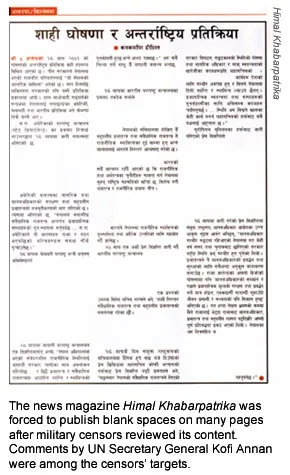 In newsrooms, where armed soldiers were still stationed or at least making frequent calls to demand changes in stories, censors interpreted the orders broadly. At Himal Khabarpatrika, the most widely read Nepali-language news magazine, several army officers pored over the first post-coup edition and made many changes. When the magazine went on sale, there were white spaces with no text in almost every story about the takeover. The magazine’s editor, Rajendra Dahal, said the censors’ targets included comments made by UN Secretary General Kofi Annan, Richard Boucher of the U.S. State Department, and British Foreign Secretary Jack Straw. “They didn’t really know how to deal with such things,” said Dahal, referring to the army major and two junior officers who were sitting in his office reviewing dummy pages for the upcoming issue. “They panicked and pulled everything so we had to leave blank spaces, even in profiles of the new cabinet ministers that were studiously neutral.”
In newsrooms, where armed soldiers were still stationed or at least making frequent calls to demand changes in stories, censors interpreted the orders broadly. At Himal Khabarpatrika, the most widely read Nepali-language news magazine, several army officers pored over the first post-coup edition and made many changes. When the magazine went on sale, there were white spaces with no text in almost every story about the takeover. The magazine’s editor, Rajendra Dahal, said the censors’ targets included comments made by UN Secretary General Kofi Annan, Richard Boucher of the U.S. State Department, and British Foreign Secretary Jack Straw. “They didn’t really know how to deal with such things,” said Dahal, referring to the army major and two junior officers who were sitting in his office reviewing dummy pages for the upcoming issue. “They panicked and pulled everything so we had to leave blank spaces, even in profiles of the new cabinet ministers that were studiously neutral.”
By then, small acts of defiance were taking place. Yubaraj Ghimire, a high-profile editor at the weekly magazine, Samay, refused to censor international reaction. “Do you want me to blank out Kofi Annan?” he demanded of his army censors. Ghimire went even further in the second week after the coup. “I told the army that I wanted specific instructions in writing on what to carry and what not to print–none of this ‘letter and spirit’ business. I wanted to see Kofi Annan or some other international figure’s name in a government directive as a banned commentator on Nepal. I didn’t get [written orders], so I just printed my paper and wrote everything–cautious criticism, but criticism nonetheless.”
 Other Nepali-language editors tried different methods of defying the restrictions imposed by the government. Soon after the Information Ministry orders were issued, five newspapers appeared with blank editorial pages; one of them, Sanghu, noted that journalism in Nepal was “in the intensive care unit and needed to be revived.” That act didn’t sit well with the authorities in Kathmandu and all five editors were summoned to the office of the senior civil servant in the city, the chief district officer. There, they were told not to publish blank pages or spaces and threatened with arrest or worse if they failed to heed the order.
Other Nepali-language editors tried different methods of defying the restrictions imposed by the government. Soon after the Information Ministry orders were issued, five newspapers appeared with blank editorial pages; one of them, Sanghu, noted that journalism in Nepal was “in the intensive care unit and needed to be revived.” That act didn’t sit well with the authorities in Kathmandu and all five editors were summoned to the office of the senior civil servant in the city, the chief district officer. There, they were told not to publish blank pages or spaces and threatened with arrest or worse if they failed to heed the order.
At this point, threats were being sent to all newspaper editors in Kathmandu. Kantipur‘s Wagle and Prateek Pradhan, editor of the sister publication, The Kathmandu Post, were summoned to a meeting with Yogeshwor Karki, the Royal Palace press secretary. Wagle said he was unable to attend the meeting, and Pradhan went alone. Later, when the phone rang on Wagle’s desk, the voice of the press secretary came on the line, informing him “this is a historic moment.” As Wagle took notes, Karki made his point clear: “He said if I didn’t cooperate in this historic moment, then the security forces could make me disappear for a few hours.” Comments like that, Wagle said, explain why self-censorship became so widespread among journalists long after the soldiers had left newsrooms.
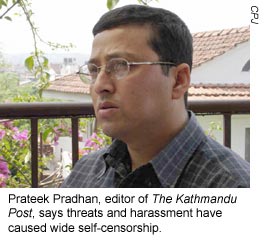 If anything, it was worse at the FM radio stations of the capital. Radio Sagarmatha had soldiers posted inside and around the station for eight days. So did several other FM outlets that specialized in news and information. Nothing but music was broadcast for the first week so the soldiers had little to do. At 5 a.m. on February 2, Monica Upadhyay, a 23-year-old reporter and news anchor at Kantipur FM, arrived at work and was accosted by four armed soldiers who appeared from the shadows. “It was so scary,” she said. “I left after my morning shift on February 1 with no soldiers in the station. Like everyone else, we’d been broadcasting only clips of the king’s speech in our regular news slots. The next morning, to see them and their guns come out of the darkness like assassins was too much.”
If anything, it was worse at the FM radio stations of the capital. Radio Sagarmatha had soldiers posted inside and around the station for eight days. So did several other FM outlets that specialized in news and information. Nothing but music was broadcast for the first week so the soldiers had little to do. At 5 a.m. on February 2, Monica Upadhyay, a 23-year-old reporter and news anchor at Kantipur FM, arrived at work and was accosted by four armed soldiers who appeared from the shadows. “It was so scary,” she said. “I left after my morning shift on February 1 with no soldiers in the station. Like everyone else, we’d been broadcasting only clips of the king’s speech in our regular news slots. The next morning, to see them and their guns come out of the darkness like assassins was too much.”
Overt censorship eased after the first week, and soldiers were withdrawn from many media outlets in the capital and elsewhere. But harassment by telephone and other means continued; editors said they received calls almost daily about coverage. “After that week,” said the Kathmandu Post‘s Pradhan, “they didn’t need to have the soldiers telling us what to do. We were censoring ourselves in fear for our jobs, and in some cases, our lives.”
Economic pressures are weighing on journalists now. Upadhyay and 13 colleagues–most of Kantipur FM’s news staff–were laid off in early March. Station managers had kept them on for several weeks, hoping for a relaxation of the rules that never came.
Up to 2,000 reporters, editors, and other news people have lost their jobs since February 1, the Federation of Nepalese Journalists, or FNJ, reported in April. An even larger number are working without pay or for a fraction of their former wages due to falling advertising revenues.
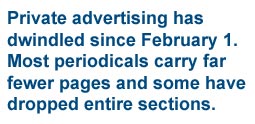 It could get worse. In late March, the Nepali-language newspaper Jana Aastha published a directive from the Information Ministry that stated government advertising would be placed only in state-owned publications. Government advertising accounts for 25 percent of the media’s revenue nationwide, according to local journalists, so the move could drive some publications out of business and leave more journalists jobless. “The biggest risk is that an entire sector–independent media–will be destroyed,” FNJ President Taranath Dahal said. “The people who now run our country have long been against private newspapers, information they can’t control. So they’re setting out to destroy us by saying we’re helping terrorism or corruption or whatever. It’s simply not true.”
It could get worse. In late March, the Nepali-language newspaper Jana Aastha published a directive from the Information Ministry that stated government advertising would be placed only in state-owned publications. Government advertising accounts for 25 percent of the media’s revenue nationwide, according to local journalists, so the move could drive some publications out of business and leave more journalists jobless. “The biggest risk is that an entire sector–independent media–will be destroyed,” FNJ President Taranath Dahal said. “The people who now run our country have long been against private newspapers, information they can’t control. So they’re setting out to destroy us by saying we’re helping terrorism or corruption or whatever. It’s simply not true.”
Private advertising has also dwindled since February 1, according to editors and publishers. Most periodicals carry far fewer pages and some, like The Kathmandu Post, have had to drop entire sections devoted to sports, culture or special events. “We’re down to our lowest level of advertising in years,” said Kunda Dixit, editor of the Nepali Times, an English-language weekly that has regularly turned a profit while adding pages, color, and content. “The big Indian multinationals don’t like the economic climate since February 1,” Dixit said. “It’s affecting all of us.”
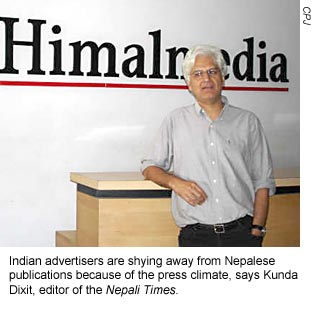 Several advertisers have told publishers that they’ve been instructed not to buy space or time in certain outlets. Kathmandu’s business sector is small and closely linked by ties of class and family background. It’s easy to send such messages through social encounters and thinly disguised gossip. “Take Kantipur for example,” said a media analyst who asked that his name not be used. “That paper has long been a thorn in the side of the army, the civil service, even the monarchy. There are active steps being taken to deny them access to advertising–successful steps. It’s working.”
Several advertisers have told publishers that they’ve been instructed not to buy space or time in certain outlets. Kathmandu’s business sector is small and closely linked by ties of class and family background. It’s easy to send such messages through social encounters and thinly disguised gossip. “Take Kantipur for example,” said a media analyst who asked that his name not be used. “That paper has long been a thorn in the side of the army, the civil service, even the monarchy. There are active steps being taken to deny them access to advertising–successful steps. It’s working.”
Officials of parent company Kantipur Publications will not say explicitly that the regime is systematically working to cut its revenue. But they do cite one government action that threatens a major company undertaking.
As the country’s largest media company, Kantipur set up a television station in 2003, hiring several hundred technicians, producers, and journalists. The first license from the government allowed only broadcasts in the vicinity of Kathmandu. Last year, the company obtained permission to link its signal to a satellite, making it widely available in Nepal and around the world. Equipment was purchased and installed this year at a cost of about US $50 million. Then, in late February, a letter arrived from the Ministry of Communications and Information.
“It was signed by a junior ministry official,” said Kailash Sirohya, managing director of the Kantipur group, “and in three or four sentences it said that our license to uplink had been revoked. No explanation, no reason given, nothing. And no one at the ministry responds to our requests for more information.” For Sirohya and his partner, Binod Raj Gyawali, the message couldn’t be clearer. They believe the government is telling them to rein in their reporters if they don’t want to lose their huge investment in satellite technology. “If it comes to it, we’ll close the TV station,” Sirohya said. “That’ll cut our losses without compromising our independence, but it would be a tragedy for journalism and broadcasting in this country.”
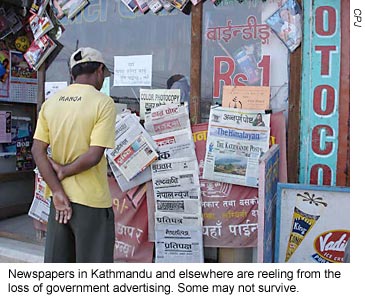 Kathmandu dominates Nepal–economically, politically and culturally. Attempts have been made to move power to other parts of the country, but these have been rendered meaningless by the growing might of the Maoist rebel insurgency outside the capital. For several years now, the security forces and the civil government have been confined to large towns and district capitals, leaving the countryside and smaller communities to Maoist control. Frequent clashes between the two sides have left more than 11,000 dead since the uprising began in 1996. Despite British, U.S., and Indian support of the security forces, observers say the government has either lost ground to the rebels or, at best, kept the conflict at a stalemate.
Kathmandu dominates Nepal–economically, politically and culturally. Attempts have been made to move power to other parts of the country, but these have been rendered meaningless by the growing might of the Maoist rebel insurgency outside the capital. For several years now, the security forces and the civil government have been confined to large towns and district capitals, leaving the countryside and smaller communities to Maoist control. Frequent clashes between the two sides have left more than 11,000 dead since the uprising began in 1996. Despite British, U.S., and Indian support of the security forces, observers say the government has either lost ground to the rebels or, at best, kept the conflict at a stalemate.
But journalism has flourished in towns beyond Kathmandu. Independent reporters work alongside employees of the government news agency and radio services in most areas of the country. Thousands of small newspapers are published at the regional, district, and village levels. Reporters for these publications show courage just by being in their posts–often caught between the security forces and the Maoists. With both sides accused of human rights abuses, the combatants have reason to object to balanced reporting about the conflict. In the past, the rebels have kidnapped and summarily executed journalists, accusing them of being spies. The security forces are suspicious of reporters’ contacts with the Maoists and try to coerce information about rebel whereabouts. This, in turn, puts reporters in danger from the Maoists.
Since February 1, reporting from rural and remote areas of the country has become even more dangerous. Dozens of journalists have been picked up by the security forces and interrogated. Some were held for only a few hours, but 10 remained in custody in mid-April, according to the FNJ.
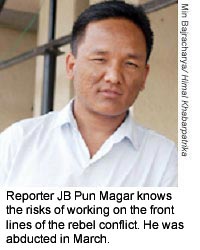 Many journalists working on the front lines of the Maoist conflict have been harassed, detained, or hurt. While investigating vigilante attacks on villagers in the southern district of Kapilvastu, JB Pun Magar, a reporter for the Nepalese newsmagazine, Himal Khabarpatrika, was held captive by masked men for several days in early March. At first, he thought his captors were Maoists, but he soon determined that they were vigilantes pretending to be rebels. He was released unharmed after being told to “report good things” about the anti-Maoist campaign in the area.
Many journalists working on the front lines of the Maoist conflict have been harassed, detained, or hurt. While investigating vigilante attacks on villagers in the southern district of Kapilvastu, JB Pun Magar, a reporter for the Nepalese newsmagazine, Himal Khabarpatrika, was held captive by masked men for several days in early March. At first, he thought his captors were Maoists, but he soon determined that they were vigilantes pretending to be rebels. He was released unharmed after being told to “report good things” about the anti-Maoist campaign in the area.
More insidious than overt arrest or abduction are the subtle yet constant threats and harassment faced by regional and local stringers for distant media houses in Kathmandu. CPJ met five of these reporters, all young men working in remote, underdeveloped districts far from their native towns. Fearing reprisal, they asked that their names not be used.
The regional stringers told chillingly similar tales of life in their districts after February 1. All said they had come under direct and indirect pressure before the king’s takeover not to report on the Maoists, but they had ignored the warnings at great personal risk. Now they face arrest, criminal charges, or worse if they simply follow their training and report on both sides of the conflict. One reporter said he had been taken aside by an army sergeant and told: “We are back to the old days now. We can do anything we want to you, so you had better behave yourself.” Another had written a number of stories about corruption in the local government and security forces and was now subject to various reprisals, including the threat of arrest and denial of a fax line.
All five stringers said their phone lines had been cut or interfered with, an action that not only silences independent journalists based in regional towns but also impoverishes them. Nepalese newspapers pay stringers only for published copy. Before February 1, the five stringers earned on average a little more than $100 per month, which was cut nearly in half after the imposition of reporting restrictions. “We can’t go on like this,” one reporter said. “I’ll have to get a job as a teacher or something.”
FM radio stations in rural areas were particularly hard hit by emergency restrictions on news broadcasting. Many of Nepal’s 46 independent radio outlets were outside of Kathmandu, broadcasting a mix of news and current affairs in 13 of the country’s local languages as well as in the national tongue, Nepali. Radio broadcasting was a growing source of employment for educated young people and the use of regional languages arguably helped diminish the appeal of the Maoists to Nepal’s many ethnic minorities, who have long felt they were outside the national, Nepali-speaking mainstream.
Stations like Radio Bheri Awas in the western town of Nepalgunj also mixed reports on national politics and events with local programs that encouraged community development. Dili BC, station manager and program coordinator at Bheri Awas, pointed sadly toward an empty studio and said, “only music these days; no need for announcers or reporters anymore.” The station hasn’t formally laid off employees, but no one is getting paid. He speculated that the army stopped his programs in regional languages because the soldiers couldn’t understand what was being said, and so opted instead to silence the broadcasts completely.
“Only the Maoists are free of government censorship here,” he said, referring to the rebels’ use of clandestine, illegal radio transmitters to broadcast propaganda across much of western and southeastern Nepal. In some of the worst conflict areas, the government restrictions have had the effect of handing over to the Maoists airwaves that once teemed with objective, relevant information programs.
Staff reporters for Kathmandu media who are based in other parts of the country have also fared poorly under the new restrictions. Rameshwor Bohara, a Himal Media correspondent based in the town of Nepalgunj, said the frequent threats he receives from both the security forces and the Maoists have confined him to reporting on noncontroversial stories such as pollution, women’s rights, and blood donation drives. Bohara used to be among the region’s more active reporters, traveling in Maoist areas and covering all sides of the sensitive, complex situation.
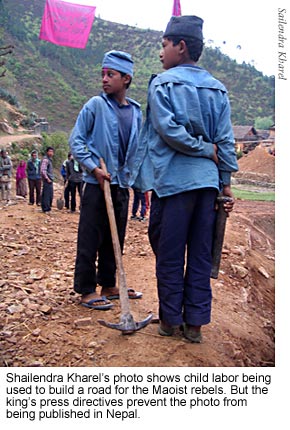 Photographers such as Shailendra Kharel of the Kantipur group have to resort to Indian and international organizations to get their pictures of everyday life in Maoist areas published. Kharel’s employers are officially prohibited from printing any material about the rebels that does not come from the army–which effectively bars his photographs of Maoists using forced labor and child labor. “The army didn’t send them, so they’re illegal,” he said, “even though they show how the Maoists are using village labor to build their road.”
Photographers such as Shailendra Kharel of the Kantipur group have to resort to Indian and international organizations to get their pictures of everyday life in Maoist areas published. Kharel’s employers are officially prohibited from printing any material about the rebels that does not come from the army–which effectively bars his photographs of Maoists using forced labor and child labor. “The army didn’t send them, so they’re illegal,” he said, “even though they show how the Maoists are using village labor to build their road.”
The Maoists often accuse Nepalese reporters of being spies–and, like the security forces, the rebels have been vicious toward these journalists. The Maoists routinely threaten rural reporters and, on occasion, abduct, torture and kill them. Dekendra Raj Thapa, a reporter for state-run Radio Nepal, was kidnapped and killed last year for alleged crimes against “the people’s regime.” In a similar 2003 incident, Maoists in the district of Sindhupalchowk, just east of Kathmandu, abducted Gyanendra Khadka, a reporter for the state-owned news agency Rastriya Samachar Samiti. They later killed him after tying his hands to a pole and slitting his throat so deeply that he was virtually beheaded. Rebels have not accounted for several other journalists who are missing and feared dead.
The Maoists have no clear policy on coverage of their activities, although their supreme leader, who styles himself “Comrade Prachanda,” has occasionally said the press is welcome in rebel-held areas. In practice, this does not translate into safe access. On the ground, few local commanders seem aware of Prachanda’s comments about the media. Both foreign and Nepalese reporters frequently encounter hostile rebels or get caught in crossfire between security forces and the Maoists. Shailendra Kharel of Kantipur was covering a rebel rally in Rolpa in March, for example, when an army helicopter opened fire. He found shelter, but his jeep was hit by gunfire.
Nepal’s leaders have often sought to keep secret even the most pressing public issues–such as the circumstances of the 2001 palace massacre that claimed the lives of King Gyanendra’s predecessor and other royal family members. But in the 14 years since the palace first allowed democracy, FM radio stations and private newspapers had demonstrated journalistic courage by chipping away at that secrecy. They competed to offer the most relevant information about politics, conflict, and public policy issues such as poverty and health care.
The influence of private media was clearly seen as a serious threat by the state, and the February 1 proclamation and subsequent restrictions were the most devastating blow to private media since democracy began.
At a Kathmandu press conference on April 12, CPJ called on the government of Nepal to end the harassment and imprisonment of journalists and to repeal restrictions imposed on private media, including the ban on FM radio news broadcasts. CPJ Executive Director Ann Cooper noted that since the beginning of democracy in 1990, private media had “developed into Nepal’s main forum for responsible, constructive public debate.”
“But now the authorities seem determined to close down that forum and force a return to the days when news and information came only from tightly restricted state media,” Cooper said. “That would be a huge loss for the Nepali public and a great setback for democracy.”
Similar messages have been delivered repeatedly by the international community since February 1, along with calls for the king and his cabinet to reverse the restrictive new media regime. In an April interview, British Ambassador to Nepal Keith Bloomfield noted that a free press is essential to peaceful resolution of the conflict in Nepal. Indian Foreign Minister Natwar Singh told his country’s parliament in late Feburary that Nepalese democracy demands freedom of the press. Official calls for a restoration of constitutional free speech and free press guarantees have come from the United States, the European Union, and the United Nations, among others.
The government’s failure to reverse the restrictions led to intense negotiations at the UN Human Rights Commission’s annual deliberations in Geneva this April. Threatened with international censure for its human rights record, the government agreed on April 11 to allow the commission to send UN human rights monitors to Nepal. By signing the agreement, the government avoided a humiliating vote on censure. But it also now faces intense scrutiny from special UN monitors, who will be deployed around the country to chronicle human rights abuses, including violations of press freedom. They are due to arrive in May.
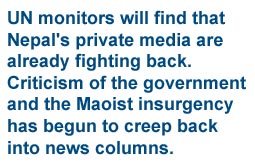 The UN monitors will find that Nepal’s private media are already fighting back. After first running white space to protest the government’s heavy-handed censorship, some newspapers and magazines have begun to test the limits. By April, criticism of the government–as well as the Maoist insurgency–began to creep back into news columns, as had news of protests against the state of emergency crackdown. Journalists began to stand up for colleagues at rival media outlets; when police summoned Kantipur‘s Wagle for questioning in March, Kathmandu journalists joined him to protest government’s attempts to intimidate the media.
The UN monitors will find that Nepal’s private media are already fighting back. After first running white space to protest the government’s heavy-handed censorship, some newspapers and magazines have begun to test the limits. By April, criticism of the government–as well as the Maoist insurgency–began to creep back into news columns, as had news of protests against the state of emergency crackdown. Journalists began to stand up for colleagues at rival media outlets; when police summoned Kantipur‘s Wagle for questioning in March, Kathmandu journalists joined him to protest government’s attempts to intimidate the media.
In a brave column on the April 9 editorial page of the Kathmandu Post, News Editor Ameet Dhakal sounded a warning to the country’s leaders. “Professional Nepali media and my generation of journalists are a product of multiparty democracy,” Dhakal wrote. “Professionally, we grew up idealizing pluralism, multiculturalism and an open society.” Thus, Dhakal said, private media are seen as a threat by undemocratic rulers. “The unitary state, ruled by a bunch of never-elected people, has a short life in the presence of independent private media that constantly questions their legitimacy and exposes their unaccountability. That’s why they are hell-bent on strangulating the free press.”
Daniel Lak was BBC correspondent in Nepal from August 2000 to January 2004. During that time, he traveled extensively in the country, including in Maoist-held areas, and covered the infamous royal massacre in June 2001. In south Asia, he has also reported from Pakistan, India, Sri Lanka, Bangladesh, Bhutan, Afghanistan, and the Maldives. Lak is now based in Miami as BBC Caribbean correspondent. This report was based on a weeklong fact-finding mission led by Lak and CPJ Executive Director Ann Cooper.